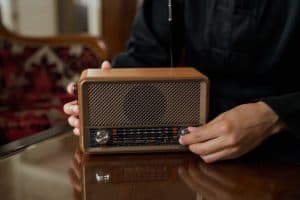
In the ear of high-speed internet, social media influencers, and apps that know our behavior better than we do, there’s a seemingly anachronistic medium making a resounding comeback: radio. Once the darling of households, radio fell out of favor as television took center stage, and then, it faced the onslaught of the internet. However, radio is not just alive; it’s thriving, and perhaps counterintuitively, it finds renewed relevance in this tech-driven, constantly connected world. Knowing the power of words and the need for constant information, radio stations have evolved to cater to a more diverse audience with a wide range of topics.
The Resurgence of Radio in Marketing
Despite predictions of obsolescence from decades past, radio has managed to find its niche in the digital marketing era. What’s driving this resurgence? It’s the intimacy and immediacy that only sound waves can provide. Unlike the visual compartmentalization of the internet and television, radio is an ambient presence, filling gaps in our day with a human touch that screen-based media struggle to replicate.
Why Brands Tune Into Radio
For marketers, this presents a golden opportunity. Radio is a way to differentiate in an overcrowded digital space. It’s a chance to engage with a captive audience without the ad fatigue often found online. Additionally, radio offers the unique advantage of locality, a treasure trove for regional branding. There’s also the cost factor. Radio ads can be more budget-friendly than online equivalents, especially for small or local businesses.
Tech Integration with Radio Marketing
Adapting to Digital
The modern radio strategist is not just versed in broadcast principles but also fluent in digital analytics. They marry the warmth of a human voice with the precision of data, using tools that track listener habits and demographics to tailor content and ads. Namely, digital radio advertising allows for specific targeting and retargeting, making it a powerful tool for direct response campaigns. Additionally, with the rise of smart speakers and voice-activated devices, brands can now integrate radio ads into these platforms to reach an ever-growing audience.
Podcasts
With the meteoric rise of podcasts, audio-on-demand is no longer a buzzword – it’s a behemoth. Brands are beginning to realize the influence these shows have and are eager to insert themselves into the conversation, whether through traditional ads or more integrated sponsorship deals.
From Passive to Engaged
Radio has integrated with social media, turning a once passive listening experience into an interactive campaign. Live tweet-ins, text-to-vote polls, and user-generated content are just a few ways that radio is leveraging digital platforms to deepen listener engagement.
Case Studies and Success Stories

Many brands are finding success in ‘sonic branding,’ crafting audio signatures that become synonymous with their products. This has the ripple effect of amplifying brand recognition, often on a global scale, via radio.
Surprisingly, it’s not just legacy brands capitalizing on radio. Newer, digitally native companies are seeing the benefits too. For many, radio presents an opportunity to break through the digital noise in a unique, low-tech, high-engagement way that resonates with a broad audience.
In addition to traditional ads, brands are also leveraging radio personalities as influencers, tapping into their loyal listener base. This human touch adds credibility and authenticity to marketing efforts, which can be hard to come by in the digital realm.
SEO Optimization for Radio Marketing
In today’s digital age, SEO (Search Engine Optimization) is pivotal for boosting the visibility of any marketing approach, including radio marketing. Combining SEO with radio ads can significantly enhance a campaign’s reach and impact. Beyond the usual web use, keywords are now vital in radio scripts to match what listeners might search online post-hearing an ad. Additionally, optimizing show notes for radio shows and podcasts on websites can drive traffic to the station’s online platforms. Embracing these tactics allows radio advertisers to connect with live audiences and sustain a robust online presence, ensuring easy discoverability and prolonged reach beyond the initial broadcast.
The Future of Radio in the Digital Landscape
The trajectory of radio’s integration into the digital realm suggests a future where this medium not only coexists with modern technologies but thrives by leveraging them. Innovations such as AI-driven content personalization and programmatic advertising are set to elevate the listener experience to unprecedented levels. By harnessing the power of big data, radio stations will be able to deliver more tailored content, ensuring that listeners stay engaged and advertisers achieve better returns on investment. Furthermore, the expansion of internet radio and podcasting platforms presents an opportunity for radio to reach a global audience, breaking free from the constraints of traditional broadcast ranges. In this evolving landscape, radio’s adaptability and enduring appeal hint at its potential to remain a key player in the multifaceted world of digital media.
In the face of rapid technological evolution and shifting consumer behaviors, radio has demonstrated remarkable resilience and adaptability. Its resurgence in the marketing world underscores not only the medium’s enduring relevance but also its capability to innovate and integrate within the digital landscape. By blending the inherent intimacy of the spoken word with the precision of digital analytics and the reach of the internet, radio offers a unique, multifaceted channel that resonates with audiences and advertisers alike. As we move forward, the continued evolution of radio—through advancements in AI, programmatic advertising, and global internet broadcasting—promises to further solidify its position as a vital component of the marketing mix.



